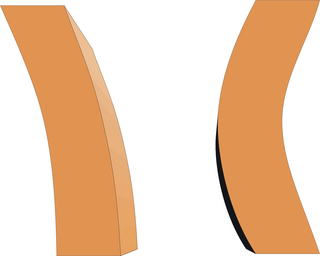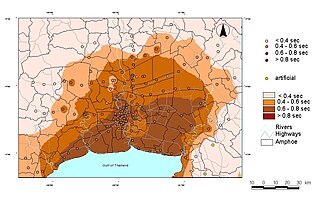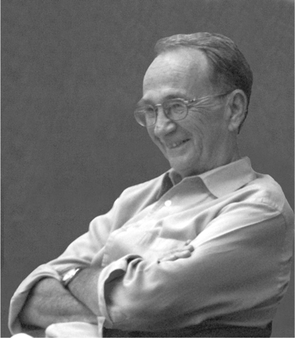Peak ground acceleration (PGA) is equal to the maximum ground acceleration that occurred during earthquake shaking at a location. PGA is equal to the amplitude of the largest absolute acceleration recorded on an accelerogram at a site during a particular earthquake. Earthquake shaking generally occurs in all three directions. Therefore, PGA is often split into the horizontal and vertical components. Horizontal PGAs are generally larger than those in the vertical direction but this is not always true, especially close to large earthquakes. PGA is an important parameter for earthquake engineering, The design basis earthquake ground motion (DBEGM) is often defined in terms of PGA.

Seismic retrofitting is the modification of existing structures to make them more resistant to seismic activity, ground motion, or soil failure due to earthquakes. With better understanding of seismic demand on structures and with recent experiences with large earthquakes near urban centers, the need of seismic retrofitting is well acknowledged. Prior to the introduction of modern seismic codes in the late 1960s for developed countries and late 1970s for many other parts of the world, many structures were designed without adequate detailing and reinforcement for seismic protection. In view of the imminent problem, various research work has been carried out. State-of-the-art technical guidelines for seismic assessment, retrofit and rehabilitation have been published around the world – such as the ASCE-SEI 41 and the New Zealand Society for Earthquake Engineering (NZSEE)'s guidelines. These codes must be regularly updated; the 1994 Northridge earthquake brought to light the brittleness of welded steel frames, for example.

A response spectrum is a plot of the peak or steady-state response of a series of oscillators of varying natural frequency, that are forced into motion by the same base vibration or shock. The resulting plot can then be used to pick off the response of any linear system, given its natural frequency of oscillation. One such use is in assessing the peak response of buildings to earthquakes. The science of strong ground motion may use some values from the ground response spectrum for correlation with seismic damage.

Seismic analysis is a subset of structural analysis and is the calculation of the response of a building structure to earthquakes. It is part of the process of structural design, earthquake engineering or structural assessment and retrofit in regions where earthquakes are prevalent.
Earthquake engineering is an interdisciplinary branch of engineering that designs and analyzes structures, such as buildings and bridges, with earthquakes in mind. Its overall goal is to make such structures more resistant to earthquakes. An earthquake engineer aims to construct structures that will not be damaged in minor shaking and will avoid serious damage or collapse in a major earthquake. A properly engineered structure does not necessarily have to be extremely strong or expensive. It has to be properly designed to withstand the seismic effects while sustaining an acceptable level of damage.
Henry John Degenkolb was an internationally known, American structural engineer in San Francisco, California, noted for his many contributions to earthquake engineering. In addition to providing the structural designs for many San Francisco Bay Area buildings, he chased earthquakes to share lessons with the profession and served as President of the Earthquake Engineering Research Institute (EERI).
The George E. Brown, Jr. Network for Earthquake Engineering Simulation (NEES) was created by the National Science Foundation (NSF) to improve infrastructure design and construction practices to prevent or minimize damage during an earthquake or tsunami. Its headquarters were at Purdue University in West Lafayette, Indiana as part of cooperative agreement #CMMI-0927178, and it ran from 2009 till 2014. The mission of NEES is to accelerate improvements in seismic design and performance by serving as a collaboratory for discovery and innovation.

National Center for Research on Earthquake Engineering is an organisation in Da'an District, Taipei, Taiwan.

Seismic microzonation is defined as the process of subdividing a potential seismic or earthquake prone area into zones with respect to some geological and geophysical characteristics of the sites such as ground shaking, liquefaction susceptibility, landslide and rock fall hazard, earthquake-related flooding, so that seismic hazards at different locations within the area can correctly be identified. Microzonation provides the basis for site-specific risk analysis, which can assist in the mitigation of earthquake damage. In most general terms, seismic microzonation is the process of estimating the response of soil layers under earthquake excitations and thus the variation of earthquake characteristics on the ground surface.
Ground–structure interaction (SSI) consists of the interaction between soil (ground) and a structure built upon it. It is primarily an exchange of mutual stress, whereby the movement of the ground-structure system is influenced by both the type of ground and the type of structure. This is especially applicable to areas of seismic activity. Various combinations of soil and structure can either amplify or diminish movement and subsequent damage. A building on stiff ground rather than deformable ground will tend to suffer greater damage. A second interaction effect, tied to mechanical properties of soil, is the sinking of foundations, worsened by a seismic event. This phenomenon is called soil liquefaction.

Earthquake-resistant or aseismic structures are designed to protect buildings to some or greater extent from earthquakes. While no structure can be entirely impervious to earthquake damage, the goal of earthquake engineering is to erect structures that fare better during seismic activity than their conventional counterparts. According to building codes, earthquake-resistant structures are intended to withstand the largest earthquake of a certain probability that is likely to occur at their location. This means the loss of life should be minimized by preventing collapse of the buildings for rare earthquakes while the loss of the functionality should be limited for more frequent ones.
The 1991 Uttarkashi earthquake occurred at 02:53:16 Indian Standard Time (UTC+05:30) on 20 October with a moment magnitude of 6.8 and a maximum Mercalli intensity of IX (Violent). This thrust event was instrumentally recorded and occurred along the Main Central Thrust in the Uttarkashi and Gharwal regions of the Indian state of Uttarakhand. High intensity shaking resulted in the deaths of at least 768 people and the destruction of thousands of homes.

Carl Allin Cornell was an American civil engineer, researcher, and professor who made important contributions to reliability theory and earthquake engineering and, along with Luis Esteva, developed the field of probabilistic seismic hazard analysis by publishing the seminal document of the field in 1968.
Thomas Denis O’Rourke is an American educator, engineer and serves as the Thomas R. Biggs Professor of civil & environmental engineering at the Cornell University College of Engineering. O’Rourke took his Bachelor of Science in civil engineering at Cornell's engineering college in 1970 and his doctorate at the University of Illinois Urbana-Champaign in 1975.
Recent advances are improving the speed and accuracy of loss estimates immediately after earthquakes so that injured people may be rescued more efficiently. "Casualties" are defined as fatalities and injured people, which are due to damage to occupied buildings. After major and large earthquakes, rescue agencies and civil defense managers rapidly need quantitative estimates of the extent of the potential disaster, at a time when information from the affected area may not yet have reached the outside world. For the injured below the rubble every minute counts. To rapidly provide estimates of the extent of an earthquake disaster is much less of a problem in industrialized than in developing countries. This article focuses on how one can estimate earthquake losses in developing countries in real time.
Seismic codes or earthquake codes are building codes designed to protect property and life in buildings in case of earthquakes. The need for such codes is reflected in the saying, "Earthquakes don't kill people—buildings do." Or in expanded version, “Earthquakes do not injure or kill people. Poorly built manmade structures injure and kill people.”

Michael John Nigel Priestley was a New Zealand earthquake engineer. He made significant contributions to the design and retrofit of concrete structures, and developed the first displacement-based method of seismic design.
The Utah Seismic Safety Commission (USSC) is a legislatively created independent advisory board that tends to seismic-hazard issues in Utah, United States. The Utah legislature created the 15-member commission in 1994 to supersede the Utah Earthquake Advisory Board and to act as a medium "for state and local governments, the private sector, and the public to advance earthquake-related issues by developing, researching, and recommending seismic policies and approaches aimed at reducing Utah's earthquake hazards and managing Utah's earthquake risk."

Sudhir Kumar Jain is the incumbent and 28th Vice-Chancellor of Banaras Hindu University. He is a civil engineer by education and has formerly served three terms as the founding director of the Indian Institute of Technology Gandhinagar. He has carried out intensive research and development in the fields of seismic design codes, dynamic of buildings, and post-earthquake studies. Beside these, Jain has actively participated in teaching, research activities and development in earthquake engineering focused on developing countries. He is an elected fellow of Indian National Academy of Engineering. He was also elected a member of U.S. National Academy of Engineering (2021) for leadership in earthquake engineering in developing countries.

Dr. Hideki "Kit" Miyamoto is a Japanese American structural engineer known for being the founder-CEO of Miyamoto International, a global structural engineering and disaster risk reduction organization. He is also the chairman of California's Alfred E. Alquist Seismic Safety Commission, which investigates earthquakes and recommends policies for risk reduction.










